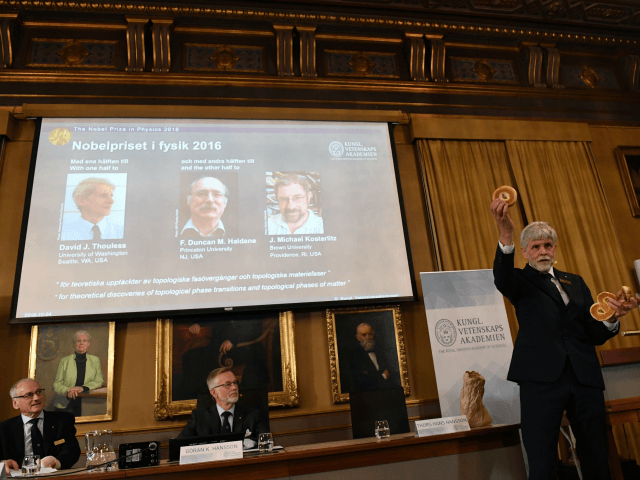(AFP) – The study of “strange states” of matter, which may one day yield superfast computers, earned British scientists David Thouless, Duncan Haldane and Michael Kosterlitz the Nobel Physics Prize on Tuesday.
The trio, all based in the US working in the highly-specialised mathematics field of topology, studied unusual phases or states of matter.
“This year’s laureates opened the door on an unknown world where matter can assume strange states,” the Nobel jury said.
“Thanks to their pioneering work, the hunt is now on for new and exotic phases of matter.”
The jury said there were hopes that their discoveries would have future uses in the fields of materials science and electronics, especially at the super-small quantum scale.
For now, however, the scientists’ discoveries remain in the realm of research.
Kosterlitz, speaking to reporters in Helsinki where he was working, joked: “I’ve been waiting for my desk-top quantum computer for years and it’s showing no signs of appearing.”
“At the risk of making a bad mistake, I would say that this quantum computation stuff is a long way from being practical.”
Thouless won half of the eight million Swedish kronor (around $931,000 or 834,000 euros) prize, while Haldane and Kosterlitz share the other half.
Topology is a branch of mathematics that investigates the physical properties of matter and space — shape in essence — that remain unchanged under certain deforming forces.
These include stretching, compressing and bending, but not piercing, tearing or gluing.
An often-used example is a rubber coffee cup being bent, twisted and reshaped into a donut — for topologists the two shapes are indistinguishable, though to the rest of us they are completely different.
In practical terms, these properties of matter may one day lead to the reshaping of common materials into “topological states” that can transport energy and information in very small spaces without overheating.
The trio’s pioneering work “boosted frontline research in condensed matter physics, not least because of the hope that topological materials could be used in new generations of electronics and superconductors, or in future quantum computers,” said the Nobel jury.
– ‘Stumbled’ on discovery –
In the early 1970s, Kosterlitz and Thouless overturned the theory that superconductivity or suprafluidity could not occur in very thin layers of material.
Superconductivity is when electricity flows through a material without experiencing any resistance or losing energy as heat, while suprafluidity is when a fluid flows without any friction.
For his part, Haldane discovered how topological concepts applied to chains of small magnets in certain materials.
Haldane said his prizewinning discovery had been serendipitous.
“Most of the big discoveries are done that way: you stumble on it and you have the luck to recognise you have something very interesting,” he told reporters at the Nobel press conference via videolink.
“It’s so surprising that it takes a while to grip, but when you see it you realise why no one had seen it before.”
Thouless, 82, is professor emeritus at the University of Washington in Seattle.
Haldane, 65, is a professor at Princeton University, and Kosterlitz, born in 1942, teaches at Brown University in Providence, Rhode Island.
For Laurent Levy, physics professor at France’s University of Grenoble, the trio’s work had yielded “a conceptual revolution”.
“They introduced new ideas and physics which have, later, resulted in heaps of new discoveries,” he told AFP.
“Above all, it advanced our understanding of the properties of matter.”
Last year, the physics prize went to Japan’s Takaaki Kajita and Canada’s Arthur McDonald for determining that neutrinos have mass, a key piece of the puzzle in understanding the cosmos.
The physics prize is the second of the Nobels for 2016 to be awarded, after the medicine prize on Monday went to Yoshinori Ohsumi of Japan.
He was honoured for his pioneering work on autophagy — a process whereby cells “eat themselves”, which can result in Parkinson’s and diabetes when disrupted.
On Wednesday, the chemistry prize will be announced, to be followed by the peace prize on Friday, the economics prize on October 10 and the literature prize on October 13.

COMMENTS
Please let us know if you're having issues with commenting.